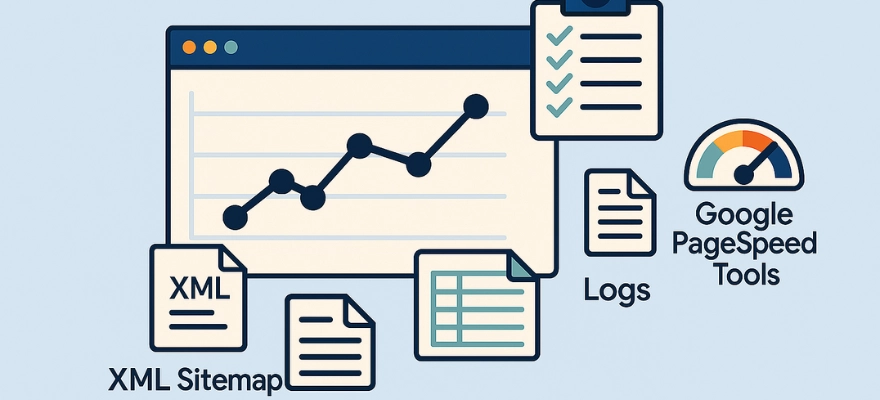Wondering why your website isn’t showing up where it should in search results?
You’ve put in the work. You’ve written content. You’ve shared it. But something’s off.
That’s where technical SEO comes in. It’s not about keywords or blog posts. It’s the stuff under the hood that makes sure your website actually works for search engines and for people.
We’re breaking it down for business owners who want to make their websites perform better. No fluff. No jargon. Just real, practical info on technical SEO, best practices, common technical issues, and how to fix them. If you care about growing your business online, this one’s for you.
Key Takeaways
- Technical SEO is essential for building a strong, secure, and high-performing website for search engines
- You don’t need to code, but understanding the technical requirements goes a long way
- Small actions like submitting sitemaps or using schema markup create results
- Tools like Screaming Frog, Google Search Console, and Ahrefs help uncover and fix hidden issues
What Is Technical SEO and Why It Matters

Technical SEO is how we optimize your website so Google, Microsoft Bing, and other search engines can crawl it, understand it, and index it properly in search engine result pages.
Without it, even the best content can get buried.
Here’s what technical SEO actually does to support your overall digital marketing success:
- Makes your site easier to crawl with tools like Screaming Frog SEO Spider or Google Search Console
- Tells search engines what to index and what to skip using meta elements like noindex tags
- Speeds up your web pages with page speed improvements like image compression and JavaScript/CSS minification (programming)
- Helps protect your users with HTTPS using Transport Layer Security and public key certificates
- Keeps your site organized with clean URLs, internal navigation, and structured XML sitemaps
It’s the technical foundation of search engine optimization (SEO). Everything else in your SEO strategy builds on it.
Why Business Owners Should Care About Technical SEO
We get it. You’re busy. But ignoring technical SEO means you’re leaving traffic and leads on the table.
Here’s why it’s a game changer:
- Your website will load faster, especially on any mobile device (good mobile usability and responsive web design is key)
- Better user experience means people stay longer, click more, and convert better
- Fewer issues with crawling, indexing, or broken internal links
- Search engines trust you more, which boosts your ranking and click-through rate
If you run e-commerce or collect personal data like credit cards, technical SEO is even more important. No one trusts a sketchy site.
Technical SEO helps build credibility with search engines and your website visitors.
Benefits of Technical SEO You Can’t Ignore

Let’s be honest: the benefits of technical SEO aren’t just technical. They’re practical.
You get:
- More visibility in search engine results pages
- A smoother user experience across all devices and web browsers
- Better return from all your marketing, social media marketing, and content marketing campaigns
- Fewer future technical SEO issues and less dependency on fixes
And the cherry on top? It supports on-page SEO and amplifies all your SEO efforts.
The Most Common Technical SEO Issues
You don’t need to be a dev to fix the big stuff. Just know what to look for.
Here’s what trips most sites up:
- Slow page speed from unoptimized images, scripts, or poor server response
- Duplicate content or wrong canonical tags
- Broken hyperlinks or poor URL redirection practices
- Poor mobile SEO or missing Accelerated Mobile Pages (AMP) setup
- Missing or misconfigured sitemaps, robots.txt, or noindex tags on important pages
- Missing authentication, password protections, or broken HTTPS setups
These are the usual suspects in any solid technical SEO audit.
How to Run a Quick Technical SEO Audit

Here’s a simple technical SEO checklist anyone can follow:
- Connect your site to Google Search Console and webmaster tools
- Crawl your site using a tool like Screaming Frog SEO Spider or Semrush
- Check for duplicate content, broken links, and URL chains
- Submit an up-to-date XML sitemap (formatted as a text file or computer file)
- Test your page speed using Google PageSpeed Tools
- Review robots.txt, meta elements, and markup language structure for clarity
- Keep logs with logging tools to track issues
Document it all in Microsoft Excel or Google Sheets for easy follow-up.
Technical SEO Best Practices We Actually Follow
These are the technical SEO best practices we stick to:
- Clean up your URLs: use readable structure, keyword clarity, and avoid messy parameters
- Speed up your site: leverage content delivery networks (CDNs), minification (programming), and lazy loading
- Optimize for mobile: use responsive web design across all mobile devices
- Add schema markup via Schema.org for enhanced search engine indexing
- Monitor and fix internal links, 404s, and URL redirection chains
- Lock down your site with HTTPS, valid certificates, and solid authentication layers
- Keep a scalable architecture and logical navigation that makes sense
This helps maintain a robust technical setup that supports all your SEO goals.
Tools We Recommend (And Actually Use)
These are the tools that handle the technical side of SEO and help you monitor how search engines crawl and index your site:
- Screaming Frog SEO Spider – the OG Frog that crawls every inch of your site
- Google Search Console – direct line to Google’s crawl and indexation data
- Ahrefs or Semrush – deep dive tools for SEO data, backlink profiles, and audits
- W3C Markup Validation Service – helps keep your HTML and markup language clean
- Google PageSpeed Tools – pinpoint your performance bottlenecks
- Yoast SEO or RankMath – top plug-in options for WordPress sites
FAQs
What is technical SEO in simple terms?
It’s how you make sure your website runs properly so search engines can understand and rank it.
Do I need it if I’m already doing on-page SEO?
Yep. On-page SEO works with content. Technical SEO makes sure it’s found and understood.
How often should I run a technical SEO audit?
At least every 3 to 6 months. Or anytime you notice traffic drops or indexing problems.
Can I do it myself?
Absolutely. Just start with basic tools and work your way through a solid checklist.
How does technical SEO help me stand out?
Most sites skip it. Nailing the technical aspects of SEO puts you ahead in both user trust and search rankings.
Conclusion
Technical SEO is the process that ensures your site is fast, secure, and optimized for both humans and bots.
It’s not just for developers or SEO agencies. It’s for any organization that wants to grow online.
When your website is optimized under the hood, you win more visibility, better usability, and stronger performance.
Want help getting started or need a deeper audit? Book a free strategy call with us and let’s make sure your site is working for you, not against you. Let’s get your website’s technical components ready for the World Wide Web.




